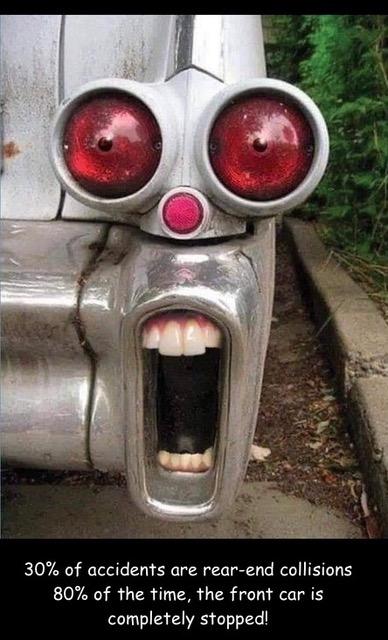
Driving Safely
Pedestrians always have the right of way; even if they are not so smart and don't use the crosswalk.
Even little cars are heavy and fast, and don't stop well on ice.
Though every tire has its own brake, cars don’t stop instantly. Otherwise your face would hit the windshield.
Give your car time to stop.
The faster you are going >>>>>>>>>>>>>>>>>>>>>>>>>>>>>>>>>>the longer it takes the car to stop.
Not everyone obeys traffic laws, and you have to watch out for them. Not everyone stops for every red light.
They are not cool, they are dangerous.
And people make honest mistakes when driving. Not everyone sees every stop sign.
In 50 years of driving, I have run past stop signs in unfamiliar neighborhoods, not even knowing the stop sign was there.
Drive as though the other driver needs to be watched.
When I was 24, I drove through an unfamiliar neighborhood, on the first day of school there.
Many schools have special speed limits during certain hours.
I got a ticket for driving the regular speed in front of a school because I didn’t see the special speed limit signs.
Stuff happens, but we need to watch for signs.
In the snow belt, when road are slick, it takes longer for a car to get moving.
But it takes waaaaaaaaaaaaaaaaay longer for the car to stop.
When it is slick outside, don’t drive if it isn’t important, and if you must drive, leave early so you can drive safely.
Also, in the summer, after a long dry spell, rainy roads can be almost as slick as ice,
because when rain hits the oil that old cars have dripped on the road, the road can be extra slick at stop signs.
‘Extra braking time’ is an important thing for drivers to practice.
Rear end collisions are the most common type of car wreck. See photo.
About 30% of wrecks are rear-end collisions, and are almost always avoidable if you follow 5 basic rules:
1) Don’t drive distracted. Phone down.
For the first six months of driving alone, my kids weren’t allowed to play the radio or have friends ride with them.
That 6 months was their 'boot camp' for driving.
2) Keep checking the car in front of you. The driver's job is to drive, not look around at other things,
unless it matters to the driving.
3) Give yourself plenty of stopping room when roads are slick or when traffic is fast.
4) When stopping for traffic lights, etc., make sure you can always see the rear tires of the car in front of you,
and that you can see where those rear tires touch the pavement.
5) Use 'the 10-per-1 rule'. For every 10 miles-per-hour you are driving, keep 1 car-length away from the car in front.
So, at 45 miles-per hour, you should be 4 ½ car lengths away from the car in front of you.
At the stop sign, again, be sure you can see the other car's rear tires touch the pavement, unless it is a really low car.
Eric J Rose
middlegrademysteries.com
photo: a random, street-photo from social media.
I suspect a '56 or '57 Caddy. My photo-guy (LP) added the script.
Some safe-driving .org should find the car owner and create a safe driving poster.